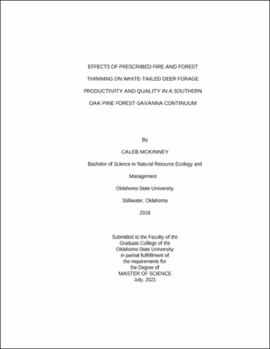| dc.contributor.advisor | Will, Rodney E. | |
| dc.contributor.author | McKinney, Caleb | |
| dc.date.accessioned | 2022-01-21T19:33:51Z | |
| dc.date.available | 2022-01-21T19:33:51Z | |
| dc.date.issued | 2021-07 | |
| dc.identifier.uri | https://hdl.handle.net/11244/333819 | |
| dc.description.abstract | White-tailed deer (Odocoileus virginiana) represent an important economic component in the management of forest lands in the USA with over 16 billion dollars of expenditures annually related to deer hunting. Climate change is expected to increase temperature and variability in rainfall, and traditional management of forests for timber production may become less viable on marginal sites on the western fringes of the eastern deciduous forest. Managing these forests for multiple objectives, including improved deer habitat, could increase the economic viability of forest management in the region. The goals of this study were to evaluate the long-term impacts of different combinations of fire return intervals and tree harvest on three major aspects of deer forage; forage productivity, timing of forage availability, and nutrient quality of forage. Aboveground net primary production (ANPP) of six functional groups (grass, panicum, forb, legume, woody, sedge) was measured in October 2019 and 2020. Percent cover of vegetation functional groups was measured monthly March through October 2019 and 2020. Foliar crude protein (CP) concentration was sampled in spring, summer, and fall of 2020 and calcium, phosphorus, potassium, in the summer of 2020. Total ANPP increased with fire frequency and tree harvest. Annual burning resulted in herbaceous dominated ANPP and longer fire return intervals resulted in roughly equal woody and herbaceous ANPP. Most functional groups peaked in coverage mid-summer, then plateaued or declined slightly in the fall. The average annual coverage results had similar trends to those for ANPP. Forb coverage peaked in April and had very little coverage in summer and fall indicating a possible source of forage early in the growing season. Crude protein concentrations were significantly greater in the forest ecosystems than in the savanna ecosystems for seven of the eleven species sampled. This increase in CP was most noticeable in the summer when deer needs for quality forage are the greatest. Foliar Ca, P, K concentrations followed a similar trend to CP concentration but were generally not significant. Increased protein and mineral concentrations in the forests indicates that a mix of savanna and forest could be ideal for balancing forage quantity and quality. | |
| dc.format | application/pdf | |
| dc.language | en_US | |
| dc.rights | Copyright is held by the author who has granted the Oklahoma State University Library the non-exclusive right to share this material in its institutional repository. Contact Digital Library Services at lib-dls@okstate.edu or 405-744-9161 for the permission policy on the use, reproduction or distribution of this material. | |
| dc.title | Effects of prescribed fire and forest thinning on white-tailed deer forage productivity and quality in a southern oak-pine forest-savanna continuum | |
| dc.contributor.committeeMember | Loss, Scott R. | |
| dc.contributor.committeeMember | Fairbanks, W. Sue | |
| osu.filename | McKinney_okstate_0664M_17317.pdf | |
| osu.accesstype | Open Access | |
| dc.type.genre | Thesis | |
| dc.type.material | Text | |
| dc.subject.keywords | deer | |
| dc.subject.keywords | fire | |
| dc.subject.keywords | forage | |
| dc.subject.keywords | quality | |
| dc.subject.keywords | savanna | |
| dc.subject.keywords | shortleaf pine | |
| thesis.degree.discipline | Natural Resource Ecology and Management | |
| thesis.degree.grantor | Oklahoma State University | |
